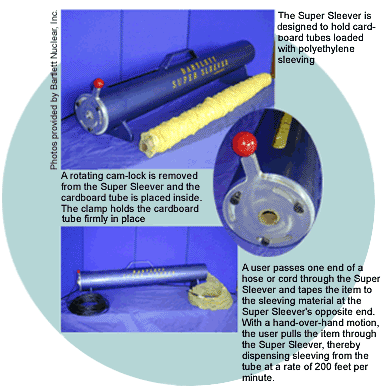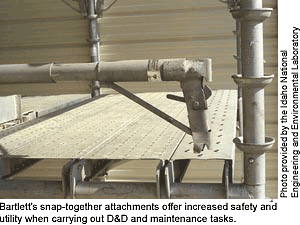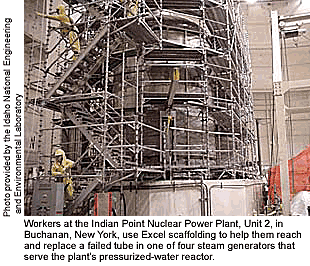|

 Company’s
products address D&D needs Company’s
products address D&D needs
The largest supplier of radiation protection personnel
and decontamination services to the U.S. nuclear power industry is
also providing equipment and specialized services that are lowering
costs for DOE’s D&D market. Bartlett Nuclear, Bartlett Services,
and other Bartlett affiliates of Plymouth, Massachusetts are supplying
two D&D products to DOE sites—the Super Sleever and the Excel
Automatic Locking Scaffold (Tech
ID 2320). These products are cutting the time required for typical
D&D and maintenance tasks.
Super Sleever
wraps up
When extension cords, cables, and hoses are used during routine maintenance
or D&D operations in contaminated areas, they inevitably become
contaminated. Since most sites don’t have the ability to easily
clean the hoses and cables to meet free-release standards, these items
are typically disposed of as low-level wastes. Another practice at
sites is for workers to hand-wrap cables and hoses in plastic to protect
them during D&D operations. Both practices have drawbacks: disposal
is wasteful, and hand-wrapping is time-consuming and expensive. Having
an efficient way to protect cables and hoses from contamination would
save many sites either labor hours or the costs of disposing these
materials as low-level waste.
The patented Super Sleever, developed by an operator at DOE’s
Savannah Rive Site, is a device for quickly and easily encasing cords,
hoses, and air lines in polyethylene protective sheaths, or sleeves,
to prevent them from becoming contaminated during routine maintenance
or D&D operations in contaminated areas. The labor required to
apply and remove the plastic sleeving dispensed from a Super Sleever
is much less than the cost of cleaning or replacing these items or
of wrapping them by hand in the conventional manner.
The Super Sleever is outfitted with a disposable cardboard tube onto
which polyethylene sleeving has been shirred. After insertion of the
disposal sleeving tube into the Super Sleever, the leading end of
a cord or hose is passed through the Super Sleever and taped to the
free end of the sleeving. As a worker pulls the hose through the tube,
the hose is encased within a sleeve. A worker can sleeve 50 feet of
hose in 15 seconds. When the entire length of the hose is contained
within a sleeve, the worker cuts the sleeve and tapes it to the end
of the hose.
Bartlett sells the Super Sleever for $500 per unit and also supplies
sleeving refills in various lengths and widths for accommodation of
cables, hoses, and cords up to 2.5 inches in diameter.
Savannah River
has sleeving experience
The idea for an improved sleeving method was conceived of by an operator
at DOE’s Savannah
River Site (SRS), who engineered a portable device for manually
dispensing a sleeve over long and comparatively narrow objects in
less than 1/10 of the time it took to sleeve objects without the device.
This device was licensed for manufacture to Bartlett, which markets
it as the Super Sleever and has supplied units to six nuclear power
plants, including Big
Rock Point near Charlevoix, Michigan, which is undergoing D&D;
Brunswick
in Southport, North Carolina; Susquehanna Steam Electric Station
in Salem Township, Pennsylvania; Pickering-Ontario Power Generation
Company in Ontario, Canada; and the U.S.
Enrichment Corporation, which operates gaseous diffusion enrichment
plants in Kentucky and Ohio.
SRS’s use of the product, beginning
in January 2000, is helping the site reuse hoses, cables, and cords
that were previously either manually sleeved or disposed of after
a single use as low-level waste. SRS expects to increase the Super
Sleever’s use across the site as
more applications are identified during the device’s
field deployments. With full use of the sleever, the site expects
to avoid 17,000 cubic feet of low-level waste annually.
| Westinghouse employee
finds a better way
Roger Brown, a Westinghouse Savannah
River Co. employee and senior operations specialist at DOE’s
Savannah River Site, has nothing good to say about hand-sleeving.
“I hate sleeving. I guess you could say I’m lazy.
But when that’s your job for eight hours, you know there’s
just got to be a better way.” Brown’s dislike of the
slow and tedious process of wrapping plastic around cords and
hoses led him to invent a device that makes sleeving seem like
child’s play. Thanks to Brown and his invention—the
Super Sleever—he and other workers at DOE sites and nuclear
power plants may soon be able to strike hand-wrapping from their
to-do lists. Sleeving 150 feet of hose once took two people
45 minutes to accomplish; but with the Super Sleever, the same
job takes one person only 45 seconds. Brown proudly reports
that his invention can potentially save the Savannah River Site
$4 million annually in labor hours and waste reduction.
Brown is enjoying the recognition his invention is earning him.
Among the awards he’s received are an Excellence in Technology
Transfer for the Southeast Region, given by the Federal Laboratory
Consortium, and a Pollution Prevention Award given by DOE, one
of four that the Savannah River Site received for 2001. Brown
also has a good chance of earning some money for his invention.
Westinghouse and Brown will share royalties on any nongovernmental
sales of the Super Sleever.
|
It's a snap
with an Excel scaffold
 Putting
together the modular pieces of Bartlett’s Excel Automatic Locking
Scaffold is akin to erecting a tower using an adult version of Tinker
Toys. Bartlett’s snap-together attachments, including swing gates,
floor hatches, ladders, trusses, cantilevers, lifting devices, and
trolley systems, offer increased safety and utility when carrying
out D&D tasks such as characterization, demolition, and asbestos
abatement. Because workers can minimize the use of hand tools while
attaching the system’s trigger-release horizontal bearers to
vertical legs, they can avoid tedious and repetitive clamp tightening
associated with the baseline scaffold. The Excel scaffold is also
faster to set up than the baseline scaffold, which contributes to
reduced labor expenditures for D&D operations, as well as for
routine maintenance chores. Putting
together the modular pieces of Bartlett’s Excel Automatic Locking
Scaffold is akin to erecting a tower using an adult version of Tinker
Toys. Bartlett’s snap-together attachments, including swing gates,
floor hatches, ladders, trusses, cantilevers, lifting devices, and
trolley systems, offer increased safety and utility when carrying
out D&D tasks such as characterization, demolition, and asbestos
abatement. Because workers can minimize the use of hand tools while
attaching the system’s trigger-release horizontal bearers to
vertical legs, they can avoid tedious and repetitive clamp tightening
associated with the baseline scaffold. The Excel scaffold is also
faster to set up than the baseline scaffold, which contributes to
reduced labor expenditures for D&D operations, as well as for
routine maintenance chores.
The Excel scaffold was demonstrated during three months in early 1999
as part of the D&D Focus Area’s Large-Scale Demonstration
and Deployment Project (LSDDP) at the Idaho
National Engineering and Environmental Laboratory (INEEL). The
demonstration investigated the feasibility of using the Excel scaffold
to access pipes, ductwork, and boiler tanks insulated with asbestos-containing
material. Comparative performance and cost data for the Excel scaffold
and the baseline tube-and-clamp scaffold substantiated Bartlett's
claims of the superiority of its Excel scaffold:
|
 The
clearly superior results obtained by the Excel scaffold at INEEL
has led to the site’s selection of it as a baseline technology
to replace the standard tube-and-clamp scaffolding for D&D work.
Larry Whitmill, project manager for the INEEL LSDDP, said that workers
recognize and appreciate the scaffold's benefits.
The
clearly superior results obtained by the Excel scaffold at INEEL
has led to the site’s selection of it as a baseline technology
to replace the standard tube-and-clamp scaffolding for D&D work.
Larry Whitmill, project manager for the INEEL LSDDP, said that workers
recognize and appreciate the scaffold's benefits. 
 Company’s
products address D&D needs
Company’s
products address D&D needs Putting
together the modular pieces of Bartlett’s Excel Automatic Locking
Scaffold is akin to erecting a tower using an adult version of Tinker
Toys. Bartlett’s snap-together attachments, including swing gates,
floor hatches, ladders, trusses, cantilevers, lifting devices, and
trolley systems, offer increased safety and utility when carrying
out D&D tasks such as characterization, demolition, and asbestos
abatement. Because workers can minimize the use of hand tools while
attaching the system’s trigger-release horizontal bearers to
vertical legs, they can avoid tedious and repetitive clamp tightening
associated with the baseline scaffold. The Excel scaffold is also
faster to set up than the baseline scaffold, which contributes to
reduced labor expenditures for D&D operations, as well as for
routine maintenance chores.
Putting
together the modular pieces of Bartlett’s Excel Automatic Locking
Scaffold is akin to erecting a tower using an adult version of Tinker
Toys. Bartlett’s snap-together attachments, including swing gates,
floor hatches, ladders, trusses, cantilevers, lifting devices, and
trolley systems, offer increased safety and utility when carrying
out D&D tasks such as characterization, demolition, and asbestos
abatement. Because workers can minimize the use of hand tools while
attaching the system’s trigger-release horizontal bearers to
vertical legs, they can avoid tedious and repetitive clamp tightening
associated with the baseline scaffold. The Excel scaffold is also
faster to set up than the baseline scaffold, which contributes to
reduced labor expenditures for D&D operations, as well as for
routine maintenance chores.